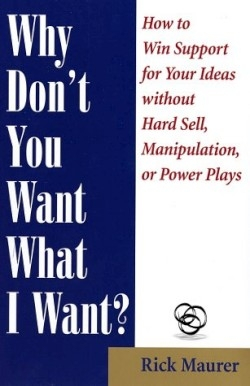
Why Don't You Want What I Want?
How to Win Support for Your Ideas without Hard Sell, Manipulation, or Power Plays
Influencing people doesn’t always require strong-arm tactics. “Better salespeople understand that building a solid relationship counts for more than any set of sales techniques.” The author gets the reader’s attention at the start of this book with a series of thought-provoking questions describing common situations where people may have difficulty convincing others. For example: “You’ve got an idea that you believe could really help your organization, but the one person who needs to grant approval isn’t interested. What would you do?”
Maurer is an organizational change consultant and lecturer based in Arlington, Virginia, serving clients such as AOL Time Warner, Lockheed Martin, and IBM. In this book, he builds on the concepts discussed in his last work, Beyond the Wall of Resistance, and includes one-on-one relationships as well as group dynamics. Focusing on the relationship between the reader and the person or group that the reader wants to influence, he describes how to deal with factors that get in the way of progress, such as resistance to change.
Several sidebars contain interviews with notable people like psychoanalyst Lynne Jacobs, actor-director Alan Alda, and Senator George Mitchell, the chair of the North Ireland Peace Process. The majority of examples, however, are real-life stories from industries like banking, hospitals, schools, and non-profit organizations. The ability to influence can make the difference between success and failure, whether for a salesperson with a customer, a manager with a vice-president, or a project leader with a team.
Since Roger Fisher’s book Getting to Yes, there have been a lot of books written on the topic of negotiating for business, but many are geared toward contracts and sales and focus more on tactics and strategies. Why Don’t You Want What I Want? is more an exploration behind the “why” of rejection and the art of building commitment. It offers six “principles of engagement” to foster understanding, trust, and a favorable reaction from another party rather than advocating specific win-lose tactics. It goes a step further and discusses ways to avoid resistance in the first place, such as “management by walking around” to build and solidify relationships.
With good writing, contemporary examples readers will be able to relate to, and smooth transitions linking the concepts discussed from one chapter to the next, this book is sure to please anyone looking to build business relationships without a hard-sell approach.
Disclosure: This article is not an endorsement, but a review. The publisher of this book provided free copies of the book to have their book reviewed by a professional reviewer. No fee was paid by the publisher for this review. Foreword Reviews only recommends books that we love. Foreword Magazine, Inc. is disclosing this in accordance with the Federal Trade Commission’s 16 CFR, Part 255.
